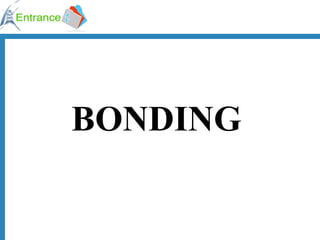
Ionic bonds ok1294990488
- 1. BONDING
- 3. LET’S FIRST REVIEW IONIC BONDING
- 4. In an IONIC bond, electrons are lost or gained, resulting in the formation of IONS in ionic compounds. F K
- 5. F K
- 6. F K
- 7. F K
- 8. F K
- 9. F K
- 10. F K
- 11. F K + _
- 12. F K The compound potassium fluoride consists of potassium (K + ) ions and fluoride (F - ) ions + _
- 13. F K + _ The ionic bond is the attraction between the positive K + ion and the negative F - ion
- 14. So What Are Covalent bonds?
- 15. In covalent bonding, atoms still want to achieve a noble gas configuration (the octet rule).
- 16. In covalent bonding, atoms still want to achieve a noble gas configuration (the octet rule). But rather than losing or gaining electrons, atoms now share an electron pair.
- 17. In covalent bonding, atoms still want to achieve a noble gas configuration(the octet rule). But rather than losing or gaining electrons, atoms now share an electron pair. The shared electron pair is called a bonding pair
- 18. Cl 2 Chlorine Forms A Covalent Bond With itself
- 19. Cl Cl How Will Two Chlorine Atoms react?
- 20. Cl Cl Each chlorine atom wants to gain one electron to achieve an octet
- 21. Cl Cl Neither atom will give up an electron –chlorine is highly electronegative. What’s the solution – what can theydo to achieve an octet?
- 22. Cl Cl
- 23. Cl Cl
- 24. Cl Cl
- 25. Cl Cl
- 26. Cl Cl octet
- 27. Cl Cl circle the electrons for each atom that completes their octets octet
- 28. Cl Cl circle the electrons for each atom that completes their octets The octet is achieved by each atom sharing the electron pair in the middle
- 29. Cl Cl circle the electrons for each atom that completes their octets The octet is achieved by each atom sharing the electron pair in the middle
- 30. Cl Cl circle the electrons for each atom that completes their octets This is the bonding pair
- 31. Cl Cl circle the electrons for each atom that completes their octets It is a single bonding pair
- 32. Cl Cl circle the electrons for each atom that completes their octets It is called a SINGLE BOND
- 33. Cl Cl circle the electrons for each atom that completes their octets Single bonds are abbreviated with a dash
- 34. Cl Cl circle the electrons for each atom that completes their octets This is the chlorine molecule, Cl 2
- 35. O 2 Oxygen is also one of the diatomic molecules
- 36. How will two oxygen atoms bond? O O
- 37. Each atom has two unpaired electrons O O
- 38. O O
- 39. O O
- 40. O O
- 41. O O
- 42. O O
- 43. O O
- 44. Oxygen atoms are highly electronegative. So both atoms want to gain two electrons. O O
- 45. Oxygen atoms are highly electronegative. So both atoms want to gain two electrons. O O
- 46. O O
- 47. O O
- 48. O O
- 49. O O
- 50. O O Both electron pairs are shared.
- 51. 6 valence electrons plus 2 shared electrons = full octet O O
- 52. 6 valence electrons plus 2 shared electrons = full octet O O
- 53. two bonding pairs, O O making a double bond
- 54. For convenience, the double bond can be shown as two dashes. O O = O O
- 55. This is the oxygen molecule, O 2 O O = this is so cool!!
- 56. Covalent bonding allows for an amazingly large variety of compounds such as
- 57. small compounds like water and carbon dioxide,
- 59. to larger compounds such as aspirin, (21 atoms)
- 60. and the sex hormones estradiol (estrogen) and testosterone, (49 atoms) (44 atoms)
- 61. to all of the 40,000 proteins you have in your body, including
- 62. insulin, with 779 atoms,
- 63. and hemoglobin, with about 9500 atoms!
- 64. There are an estimated 10 40 possible compounds containing up to 50 atoms The known chemical world, including natural and synthetic compounds, is far far far below 1% of that.
- 65. As of 2007, there are about 31,000,000 known compounds; About 12.5 million of those are commercially available. Thousands of new compounds are discovered or synthesized every week !
